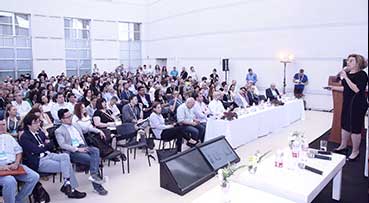The future of work goes beyond just the world of knowledge workers, and it’s more than the debate around remote or office settings.
A year into the pandemic, I’m sat down with a new CEO to discuss how the “Future of Work” trends are reshaping his industry. We were looking at a slide headlined “Everywhere is the New Location,” and he was visibly frustrated because his business depends on people being in specific places at set times. The whole “work from home” trend, even during Covid, just didn’t fit his scenario. So, he challenged me: “If our employees aren’t knowledge workers and working remotely isn’t an option, what’s the relevance here?”
A lot of leaders have got it wrong thinking the big takeaway from Covid is just the shift to remote or hybrid work setups. But it’s more than that. Work from anywhere is both a capability and an expectation across all industries today. Because the question is not just about whether your people can do their jobs from anywhere. It’s about whether they have options that include work from anywhere, and whether these options provide them with benefits they truly value.
And the answer is likely yes, even for those working shifts or in onsite roles, like in retail, food service, or hospitality. Many employees have realized over the past few years that some jobs aren’t tied down to one spot, a set schedule, or even a single employer. Look at the Gig Economy for instance. According to TeamStage’s stats, the gig economy in the US is growing three times faster than the US workforce overall, now encompassing 39% of US workers. It’s expected to surpass 50% by 2027, a huge leap from just 10% in 2005. Nowadays, 80% are choosing to be full-time independents, with only 19% feeling they’re in it reluctantly—a big change from 34% in the early 2000s. Nearly half of gig workers say they value the independence and control, while 44% are in it for a better balance between career and family. Plus, 51% wouldn’t go back to traditional jobs, no matter the pay.
This is why it’s crucial for leaders to grasp that their teams might not be looking for the literal ability to work from anywhere, but they do crave what that capability offers: flexibility, autonomy, and a better work-life balance.
Transforming a Logistical Challenge into a Strategic Opportunity
One of the most significant chances to meet this need kicks off with how we schedule work. When companies weave flexible scheduling into their operational plans, they can flip what might seem like a logistical headache into a serious competitive edge. This shift not only boosts employee happiness but also improves customer service and the overall efficiency of operations.
It calls for a move away from the traditional top-down, management-driven approach to creating schedules towards a more collaborative form of scheduling, where employees have a say. This means adopting tech platforms that let workers share their availability, request days off, or swap shifts without needing a manager’s okay. This approach fosters a sense of autonomy and respect. But perhaps even more crucial is shifting from a rigid, one-size-fits-all schedule to one that’s tailored to fit individual needs and preferences. In essence, this is about seeing shifts not just as a workforce structure but as something that meets the organization’s needs. For instance, if you need five people onsite from 8 am to 8 pm, six days a week, it shouldn’t matter whether someone works five full-time shifts or splits it into part-time shifts, as long as the total coverage meets your needs. Now, rather than penalizing last-minute changes to the schedule, consider creating systems that reward flexibility. This could mean giving bonuses to employees who step in on short notice or offering time off in exchange for unplanned work hours, recognizing the importance of flexibility for both the employee and the employer.
This strategy offers dual advantages. First, it makes your schedules more flexible for employees, acknowledging the varied situations of your workforce and attracting candidates who value customized scheduling options. Secondly, it presents a significant business opportunity by transitioning from fixed schedules based on conventional work hours to dynamic scheduling that matches real-time demand with employee availability. This approach allows you to identify core hours when full participation is essential, while also providing flexibility at the beginning or end of shifts. Alternatively, you could let employees choose their shifts freely, focusing less on the total hours or number of shifts and more on meeting peak demands. For some, the option to work shorter hours during busy times is actually appealing. Combining this with predictive analytics to anticipate customer flow, you can align staffing levels more closely with business needs. By offering shifts that suit employees’ availability and preferences, you achieve a win-win: better coverage for business demands and greater satisfaction for your staff.
Adopting flexible scheduling isn’t just a smart move; it’s a strategic overhaul that touches both your workplace culture and your business management style, fostering a culture rooted in flexibility. Perfecting it will be a journey. It’s vital to keep the lines of communication open, actively seeking feedback from your employees about their scheduling needs and hurdles, and using this feedback to fine-tune your scheduling approach. Encourage your managers to set the standard, adopting flexible scheduling themselves and supporting their teams towards achieving a balanced work-life rhythm. Transparency is key, so ensure that all team members are well-informed about scheduling policies, any adjustments to their schedules, and the reasoning behind these decisions.
By embracing these changes, organizations can forge a workplace that’s not only more adaptable and resilient but also more appealing to both current and potential employees, tapping into the full potential of their workforce in the shifting work landscape. In doing so, they’re positioned not just to meet the evolving needs of their employees but also to boost operational efficiency, enhance customer satisfaction, and strengthen overall business resilience amid constant changes.

![large-AX1A2125-2[1] large-AX1A2125-2[1]](https://niritcohen.com/wp-content/uploads/elementor/thumbs/large-AX1A2125-21-pnzedcs72atx5aeurqytqdiihxixlq02re9mlz805s.jpg)






